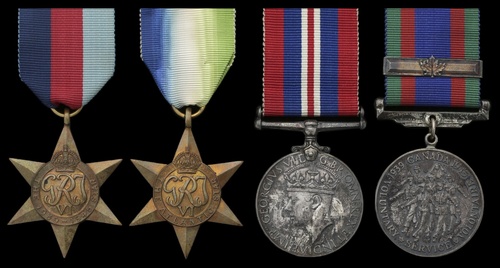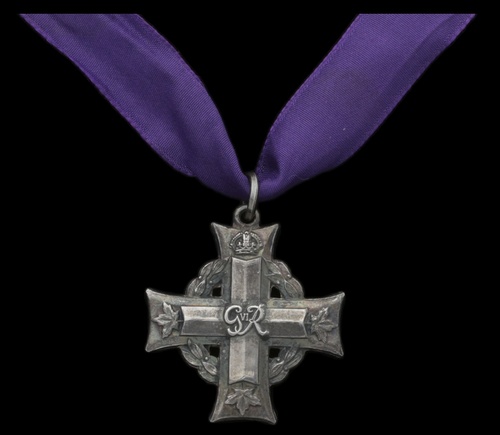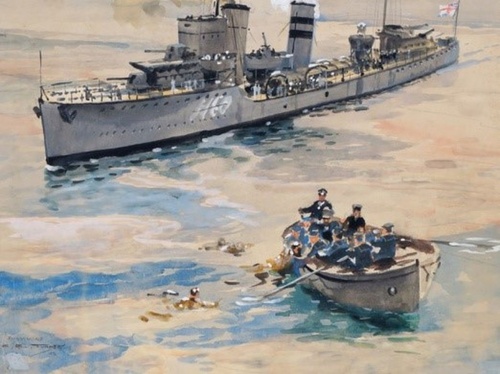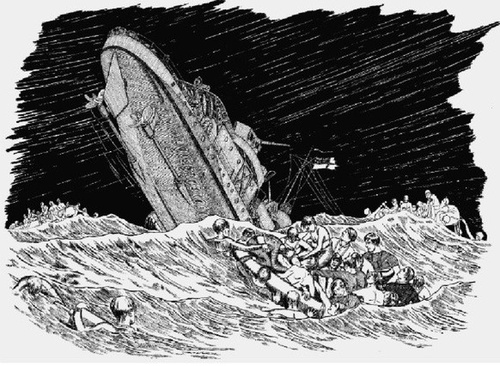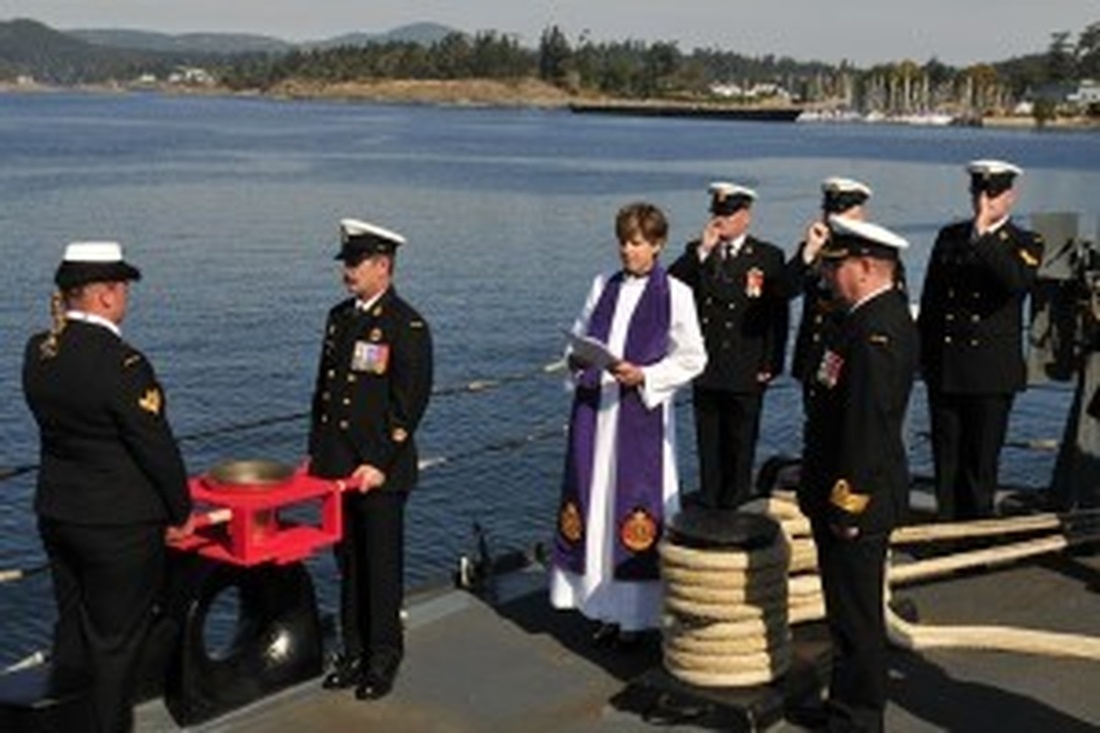Auction: 22003 - Orders, Decorations and Medals
Lot: 405
THE ATLANTIC RUN
'In the after upper mess-deck a group of about 20 men were clustered by a hammock netting. A number were terribly wounded. Men with grotesquely twisted limbs were lying there; it was like a scene from hell …
Back on the bridge I found the captain and the First Lieutenant engaged in firing a rocket, a signal that we had been torpedoed. At almost that very moment a second torpedo hit us, this time in number 2 boiler room, a huge flash then water deluging downwards on us. It was obvious that the ship was doomed.
She started to settle in the water and the captain called out to "abandon ship!" Men were trapped in the Asdic compartment in the bottom of the ship and called up the voice pipe. I cannot bear to think of it. Others were trapped in the seamen's wash place, where a sliding steel door had jammed shut. If one thinks of war as a policy, also think for a moment what I heard that night and cannot bring myself to describe … Strong men become little children crying for their mothers, not like John Wayne the motion picture hero …'
Lieutenant L. B. Jenson, R.C.N., recalls the loss of H.M.C.S. Ottawa in September 1942.
A poignant Second World War campaign group of four awarded to Supply Assistant C. M. Zinck, Royal Canadian Naval Volunteer Reserve, who was among those lost when H.M.C.S. Ottawa was torpedoed in the north Atlantic on 13 September 1942
1939-45 Star; Atlantic Star; Canadian Voluntary Service Medal, with overseas clasp; War Medal 1939-45, Canadian issue in silver, all in card boxes of issue; Canadian Memorial Cross, G.VI.R., the reverse officially inscribed, 'C. M. Zinck Supply Asst. R.C.N.V.R.', in case of issue, extremely fine (5)
Cyril Milford Zinck was born in Halifax, Nova Scotia, Canada, on 16 October 1910, and served during the Second World War as a Supply Assistant in the Royal Canadian Naval Volunteer Reserve from 17 August 1940.
He was killed in action when H.M.C.S. Ottawa, on convoy duty with Convoy ON-127, was torpedoed and sunk by the German submarine U-91 south of Greenland just before midnight on 13 September 1942, with a loss of 141 lives.
Three days earlier the Ottawa had picked up 24 survivors from the steam tanker Empire Oil which had been sunk by the U-659 and U-584 south-west of Iceland; just a handful of them survived Ottawa's subsequent loss.
Of her subsequent loss, Lieutenant L. B. Jenson, R.C.N., who was on the bridge when the first torpedo hit the Ottawa, later recalled:
'An amazing geranium-colour flash forward was followed by a great pillar of water which went straight up! All of us took shelter under the overhang at the front of the bridge as the water and all sorts of solid objects tumbled down from the sky. When the downpour stopped, I went back to the compass and we stopped engines. The ship lay still in the water, rocking gently. The forecastle with anchors and cables together with A Gun had vanished, and the forward canopy with B Gun drooped down towards the water. This was visible because the interior lights were all on and shining out all over the ocean. We obviously were a lovely target so the engines were ordered slow astern … Mr. Jones left the bridge and hurried at once to the quarterdeck, where he set all the depth charges to "safe" so that if the ship sank survivors would not be blown up by our own charges.
I asked the captain if I could do a quick inspection and report back. He agreed and I went down the ladders to the starboard passage into the mess-decks. The forward mess-decks, upper and lower, were gone, and the ocean splashed outside the great open hole, illuminated by the mess-deck lights and a calcium flare from a lifebuoy burning in the tossing waters. In the after upper mess-deck a group of about 20 men were clustered by a hammock netting. A number were terribly wounded. Men with grotesquely twisted limbs were lying there; it was like a scene from hell …
Back on the bridge I found the captain and the First Lieutenant engaged in firing a rocket, a signal that we had been torpedoed. At almost that very moment a second torpedo hit us, this time in number 2 boiler room, a huge flash then water deluging downwards on us. It was obvious that the ship was doomed.
She started to settle in the water and the captain called out to "abandon ship!" Men were trapped in the Asdic compartment in the bottom of the ship and called up the voice pipe. I cannot bear to think of it. Others were trapped in the seamen's wash place, where a sliding steel door had jammed shut. If one thinks of war as a policy, also think for a moment what I heard that night and cannot bring myself to describe … Strong men become little children crying for their mothers, not like John Wayne the motion picture hero.'
Able Seaman C. R. Skillen was at his action station at one of the destroyer's anti-aircraft guns when he was ordered forward to assist the wounded. As he would later recall, he never got there:
'As I stepped onto the first rung of the ladder to the upper deck, the second torpedo hit us amidships and split Ottawa in two. It hit directly below me, and when I came to, I was lying on the upper deck, aft of the stern-most funnel, with my legs, somehow pinned by the guard rail. I struggle to free myself, but to no avail, As I lay there, I knew that the bow of the ship had already sunk and that it was only a matter of time before the stern would follow suit. That is when the thought entered my mind that I was going to die.
However, I wasn't going to give up that easily. I said a little prayer to my Maker, asking him to forgive me, and then I gave it another try. My leg came free and I rolled myself into position and slipped into the cold waters of the North Atlantic.'
Lieutenant Jenson, by now hanging onto a spar, watched the Ottawa sink and leave a deluge of oil on the surface:
'It was all over my face, my head and hands. The smell filled the air and the taste was in my mouth. Gradually it lessened and the waves were now fresh and clean. Three or four Carley floats bobbed around hundreds of yards away. They were crowded with men, some of whom were sitting inside the floats, and the floats kept turning over. Each time there would be fewer men on the float.
Now to my astonishment the ships of the convoy passed through us - the huge ships' sides (how could they be so big?) and small people at the top calling down to us. One voice told us they dare not stop and I hoped they wouldn't because we would still be in the water when they were fished (torpedoed) …
The night was getting darker, the waves were steeper, the breeze stronger and it seemed to be raining. The men on one of the rafts were singing. I recognized the cheerfully commanding voice of the gunner's mate, Petty Officer George Grivel, a splendid man. The songs were "Pack up Your Troubles," "It's a Long Way to Tipperary" and "There's a Long Long Trail Awinding to the Land of My Dreams." These were the hit songs of the First World War, sung by our fathers and uncles as they had faced death in the hideous mud and trenches of the Western Front.'
Able Seaman Skillen continues:
'When I surfaced, I could hear my shipmates yelling and moaning in the distance. I made my way towards the noise, but all the while I watched the stern of Ottawa slowly disappear beneath the surface. I was pretty certain that there would not be an explosion from the depth charges, since these had been rendered safe. Soon I came across a Carley float, and this would be my lifeline for the next five hours. Although the seas became rougher as time passed and more and more of my shipmates succumbed, one by one, to the cold, slipping silently away, I clung to that float, knowing that one wrong move would spell the end. I wanted to sleep so bad, with the sea lulling me into a false sense of warmth, but I knew that if I shut my eyes, I would suffer the same fate as my shipmates. Therefore I hung on with grim determination. The sea tossed the Carley float about like an old inner tube. I think that there had been originally twenty-two of us clinging to it, but there was only about six of us left, when suddenly out of the dark loomed the outline of a ship. I soon recognized it as one of the escort group and they had found us!'
The rescue vessel was the British corvette H.M.S. Celandine, and when Lieutenant Jenson was identified as an officer, he was directed to the wardroom where he encountered a shipmate from Ottawa:
'Immediately I entered, Barriault, our leading steward, came over and said, as if nothing unusual had happened, "Good evening, sir. Would you like a cup of tea?"
So I replied, "Good evening, Barriault. That would be very nice, thank you," and had a cup of delicious, wonderful hot tea.'
Of the Ottawa's crew of 213 officers and men, just 65 survived. Zinck was not among them and he is commemorated on the Halifax Memorial, Canada.
Postscript
The following article appeared in Lookout Navy News in September 2012:
'H.M.C.S. Ottawa I honoured. The water casting party, P.O.1 Keith Fairman and M.S. Ley Ireland, commit the blessed water to the sea to commemorate the 70th Anniversary of the sinking.
The crew of H.M.C.S. Ottawa were joined by past commanding officers and veterans on September 14 to commemorate the 70th anniversary of the sinking of the original destroyer H.M.C.S. Ottawa and crew.
Once the ship's company had fallen into divisions on the flight deck the ceremony began.
"Let us think reverently of those comrades who laid down their lives for sovereign and country," said Commanding Officer Cdr. Scott Van Will to his crew. "Let us be mindful of the cost of freedom and peace. May our country and its people be worthy of their sacrifice."
Then, the ship's flag was lowered to half mast.
Padre Lt. (N.) Jeannine Friesen led a naval prayer and blessed the water in Ottawa II's ship bell and M.S. Ley Ireland and P.O. 1 Keith Fairman committed the water over the side of the ship.
The ship's bell rang once in memory of Ottawa I and two minutes of silence followed.
Amazing Grace was piped on the bagpipes.
"We commemorate the sinking every year, but this is the first year we have reached out to veterans and past commanding officers," said Ottawa's coxswain, C.P.O. 1 Sid Tobias. "It gives the sailors a direct reference point to think about and brings them closer to the sacrifice of service. It is our responsibility to mark this each year," he said.
Veteran Ed Dallin attended the ceremony. His brother was a stoker on the original Ottawa from 1938 to 1941.
"This brings back a lot of memories for me," said Dallin. "My brother got off the ship before it sank the following year. He was glad he wasn't on it. It means a lot for me to be here today."
H.M.C.S. Ottawa was built as British H.M.S. Crusader H60 in 1931 and transferred to Canada in 1938 and renamed H.M.C.S. Ottawa.
During the Second World War, Ottawa escorted convoys between Great Britain and Canada. On September 13, 1942, the ship was torpedoed off the coast of St. John's, Newfoundland. A second hit broke the ship in half and sunk it. Only 65 survivors were rescued from the freezing Atlantic waters, while 114 died.
The current H.M.C.S. Ottawa is the fourth generation of Ottawa in the Canadian Navy.'
Subject to 20% VAT on Buyer’s Premium. For more information please view Terms and Conditions for Buyers.
Sold for
£450
Starting price
£350

